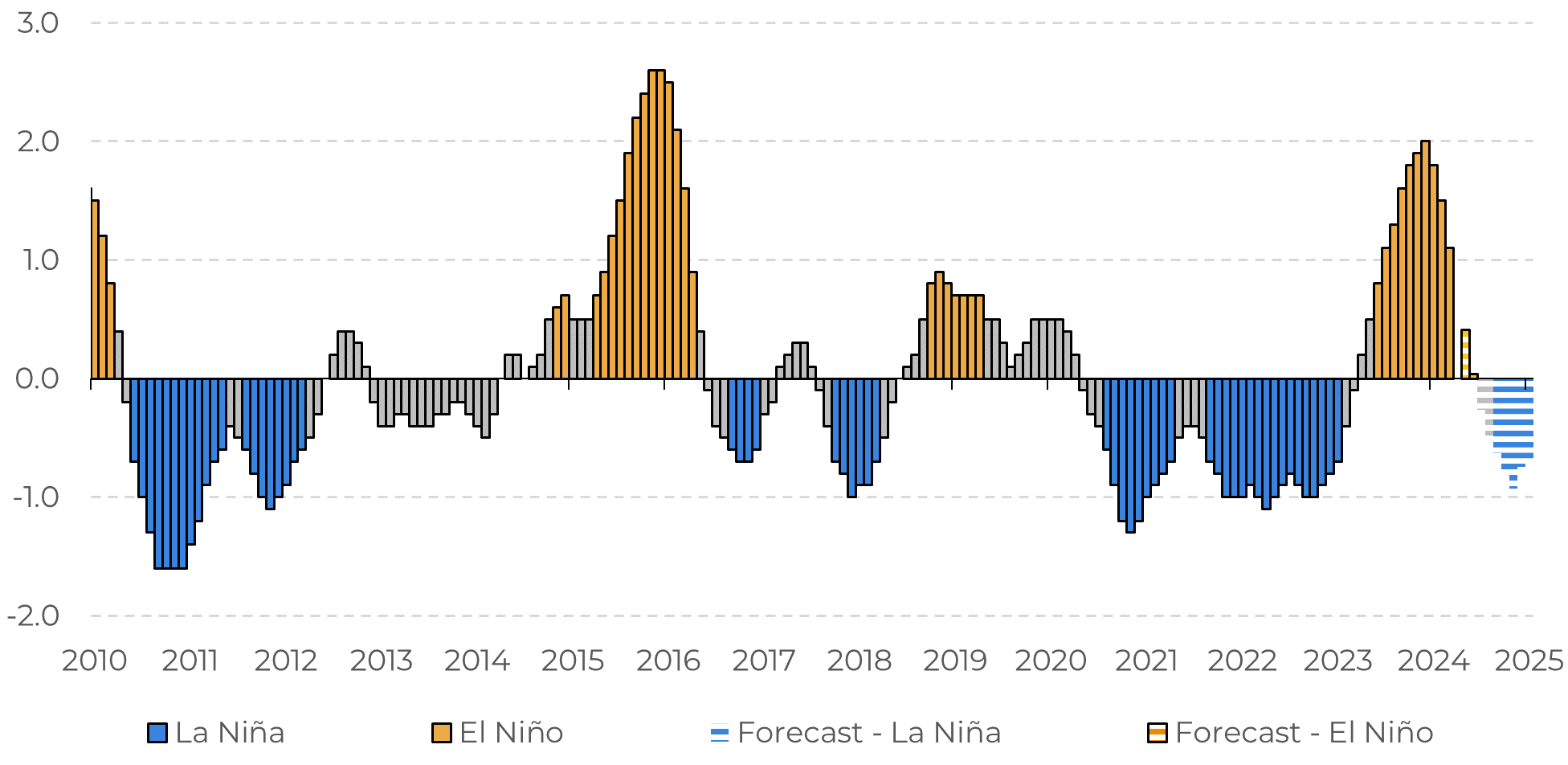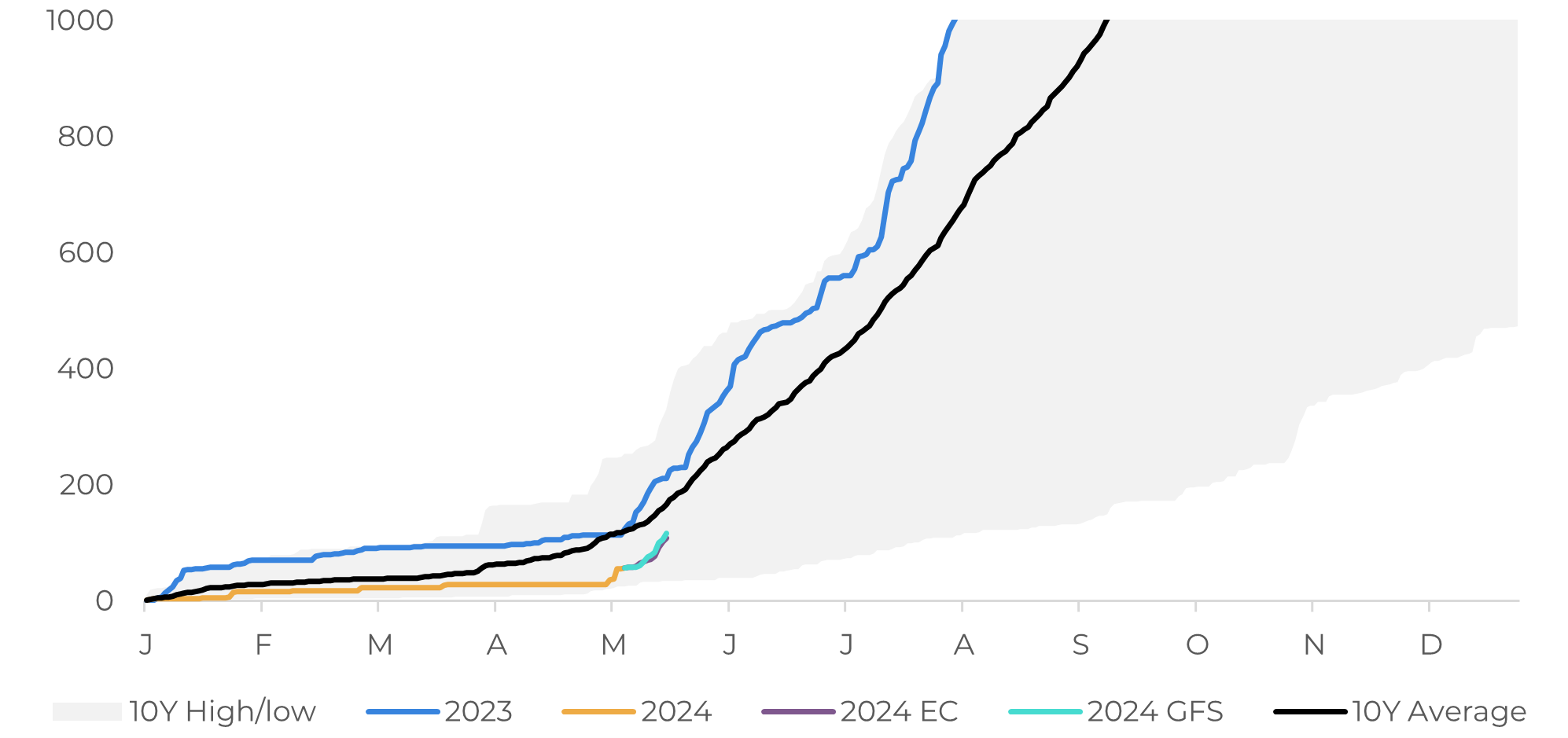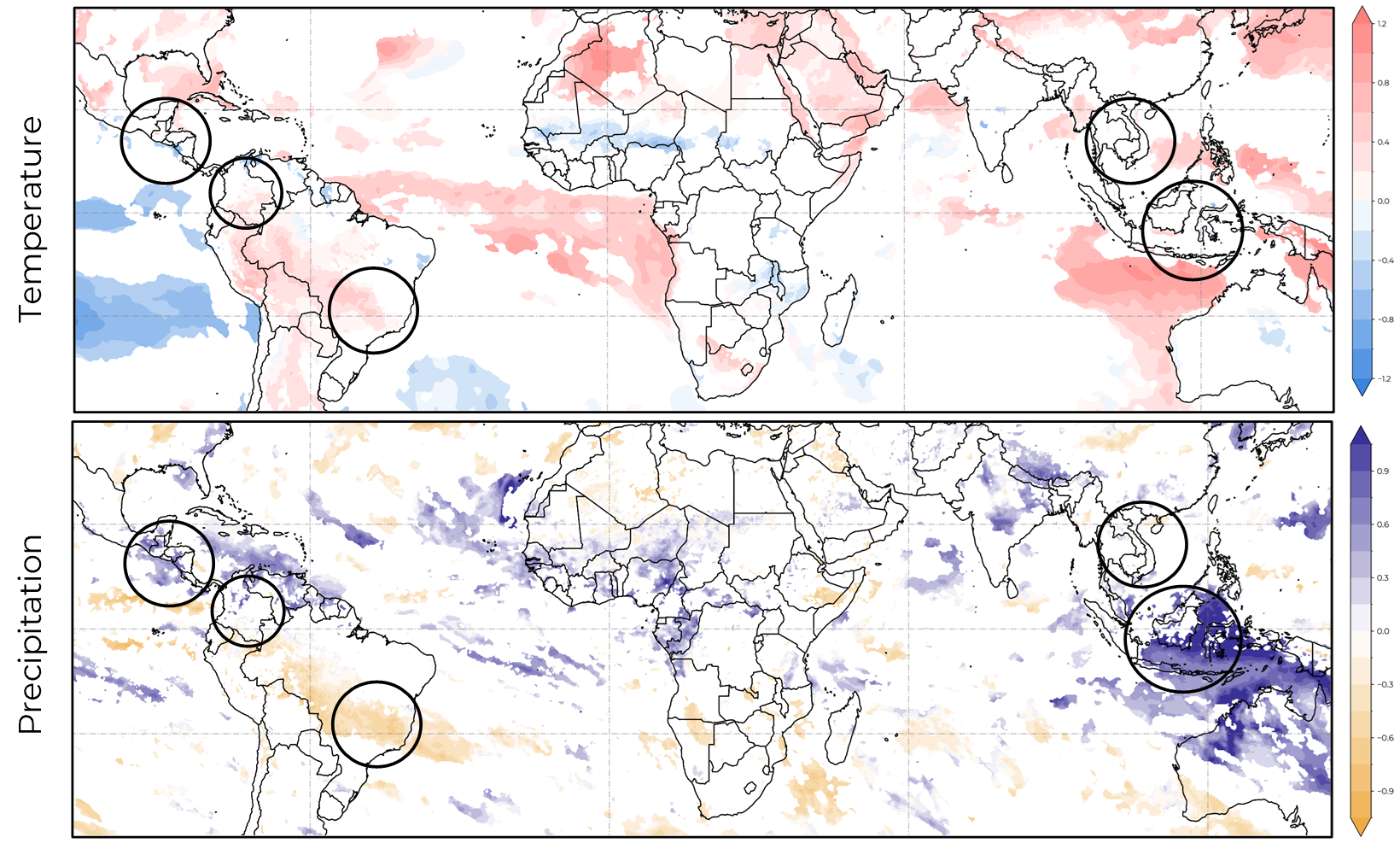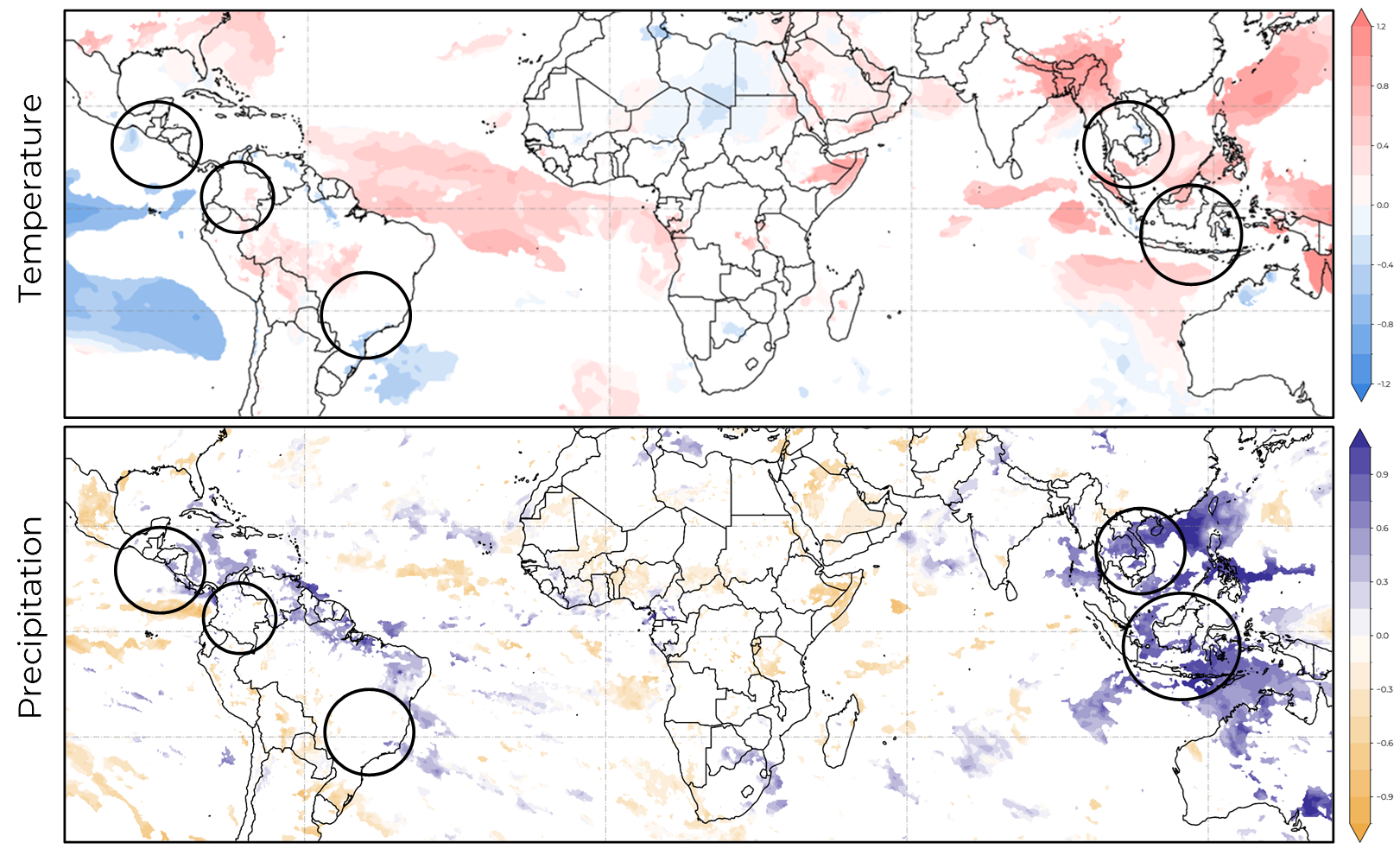
May 10
/
Natália Gandolphi
Coffee Weekly Report - 2024 05 10
Back to main blog page
- The U.S. Climate Prediction Center's forecast indicates a transition from El Niño to La Niña within the upcoming month, with implications for the coffee market in various regions. La Niña's delay could provide short-term pressure to Vietnam's 24/25 crop development with the extension of El Niño’s impact. Cumulative rainfall remains below average in the Central Highlands.
- In Brazil, attention shifts to the 25/26 crop as La Niña may bring water stress similar to the 21/22 season in September. This transition could also intensify the hurricane season in Central America and lead to higher temperatures in Colombia's coffee-producing regions.
- While concerns decrease in Brazil by October, persistent worries remain in Central America, regarding both the region's coffee harvest and the overall hurricane season.
- La Niña's delayed transition creates short-term challenges for Vietnam, while Brazil faces potential medium-term effects on its 25/26 harvest. The situation demands careful monitoring of weather patterns across major coffee-producing areas.
La Niña’s Timing: What to expect?
This week, coffee prices remained on the downtrend, alongside other softs commodities. Prices have also mirrored other benchmarks, such as oil: front-month WTI prices fell by roughly 8% since mid-April, and while coffee responded more aggressively (about -15%), it stayed in the middle of the road between sugar and cocoa (roughly -10%, and -30%, respectively, considering the previous highs).
So far, price decreases have been more correlated to spec moves than fundamentals themselves. For instance, in our monthly analysis, we’ve been observing the vulnerability implicit to record-high spec positions (Figure 1). It is important to note, however, that going by the correlation between prices and spec position, there was more room for correction, towards 202-209 c/lb, considering a linear regression for the past 70 periods, since January 2023 and the 5-year series – the level that the first contract is currently testing (Figure 2).
Other points have also been watched by the market, despite not currently altering the global Supply & Demand balance: results from coffee roasters showed a slowdown in the first quarter, especially for results that reflect more in-home consumption. KDP, for instance, posted a -0.3% variation in U.S. coffee volume sales in 1Q/24, and a 1% drop compared to the same period last year.
Figure 1: ONI Index – ENSO Status (°C)

Source: IRI
Figure 2: Cumulative Precipitation – Central Highlands (mm)

Source: Refinitiv
The transition between the two ENSO stages is expected to take longer than initially expected. With this, the focus turns to the 3rd quarter: in September, the phenomenon could generate water stress in Brazil, such as the impact seen on the 21/22 crop – precipitation and temperature anomalies are highlighted in the maps in Figure 3, indicating the climate may become hotter and drier.
It is also worth paying attention to Central America, as La Niña could intensify the hurricane season in the region, and also to Colombia, with higher temperatures in some of the coffee producing areas.
With the phenomenon continuing until the end of the year, in October, concerns decrease in Brazil, but remain in Central America. In Colombia, specific regions may experience a reduction in rainfall – special attention should be paid to the main harvest.
In this scenario, the later transition between phenomena ends up causing more concerns for Vietnam in the short term, while the highlight for Brazil should happen in the medium term, focusing on the 25/26 harvest.
Figure 3: Temperature and Precipitation Anomalies for La Niña September

Source: NOAA, Hedgepoint
Figure 4: Temperature and Precipitation Anomalies for La Niña October

Source: NOAA, Hedgepoint
In Summary
The U.S. Climate Prediction Center has forecasted a shift from El Niño to La Niña in the upcoming month. A late transition means that El Niño will still have more influence over Vietnam’s 24/25 crop development.
Despite some rainfall in Vietnam's Central Highlands, overall precipitation remains below average. The focus also shifts to Brazil's 25/26 crop, as La Niña could cause water stress similar to the 21/22 season, in September. Central America and Colombia may experience intensified hurricane seasons and higher temperatures, respectively. Although concerns ease in Brazil by October, they persist in Central America. This delay in transition presents short-term concerns for Vietnam and medium-term attention for Brazil's 25/26 harvest.
Weekly Report — Coffee
Written by Natália Gandolphi
natalia.gandolphi@hedgepointglobal.com
natalia.gandolphi@hedgepointglobal.com
Reviewed by Laleska Moda
laleska.moda@hedgepointglobal.com
www.hedgepointglobal.com
Disclaimer
This document has been prepared by hEDGEpoint Global Markets LLC and its affiliates ("HPGM") exclusively for informational and instructional purposes, without the purpose of creating obligations or commitments with third parties, and is not intended to promote an offer, or solicitation of an offer, to sell or buy any securities or investment products. HPGM and its associates expressly disclaim any use of the information contained herein that may result in direct or indirect damage of any kind. If you have any questions that are not resolved in the first instance of contact with the client (client.services@hedgepointglobal.com), please contact our internal ombudsman channel (ouvidoria@hedgepointglobal.com) or 0800-878-8408 (for clients in Brazil only).
Contact us
hedgepointhub.support@hedgepointglobal.com
ouvidoria@hedgepointglobal.com
Funchal Street, 418, 18º floor - Vila Olímpia São Paulo, SP, Brasil
This page has been prepared by Hedgepoint Schweiz AG and its affiliates (“Hedgepoint”) solely for informational and instructional purposes, without the purpose of instituting obligations or commitments to third parties, nor is it intended to promote an offer, or solicitation of an offer of sale or purchase relating to any securities, commodities interests or investment products. Hedgepoint and its associates expressly disclaim any use of the information contained herein that directly or indirectly result in damages or damages of any kind. Information is obtained from sources which we believe to be reliable, but we do not warrant or guarantee the timeliness or accuracy of this information. The trading of commodities interests such as futures, options, and swaps involves substantial risk of loss and may not be suitable for all investors. You should carefully consider wither such trading is suitable for you in light of your financial condition. Past performance is not necessarily indicative of future results. Customers should rely on their own independent judgement and/or advisors before entering in any transaction.Hedgepoint does not provide legal, tax or accounting advice and you are responsible for seeking any such advice separately.Hedgepoint Schweiz AG is organized, incorporated, and existing under the laws of Switzerland, is filiated to ARIF, the Association Romande des Intermédiaires Financiers, which is a FINMA-authorized Self-Regulatory Organization. Hedgepoint Commodities LLC is organized, incorporated, and existing under the laws of the USA, and is authorized and regulated by the Commodity Futures Trading Commission (CFTC) and a member of the National Futures Association (NFA) to act as an Introducing Broker and Commodity Trading Advisor. HedgePoint Global Markets Limited is Regulated by the Dubai Financial Services Authority. The content is directed at Professional Clients and not Retail Clients. Hedgepoint Global Markets PTE. Ltd is organized, incorporated, and existing under the laws of Singapore, exempted from obtaining a financial services license as per the Second Schedule of the Securities and Futures (Licensing and Conduct of Business) Act, by the Monetary Authority of Singapore (MAS). Hedgepoint Global Markets DTVM Ltda. is authorized and regulated in Brazil by the Central Bank of Brazil (BCB) and the Brazilian Securities Commission (CVM). Hedgepoint Serviços Ltda. is organized, incorporated, and existing under the laws of Brazil. Hedgepoint Global Markets S.A. is organized, incorporated, and existing under the laws of Uruguay. In case of questions not resolved by the first instance of customer contact (client.services@Hedgepointglobal.com), please contact internal ombudsman channel (ombudsman@hedgepointglobal.com – global or ouvidoria@hedgepointglobal.com – Brazil only) or call 0800-8788408 (Brazil only).Integrity, ethics, and transparency are values that guide our culture. To further strengthen our practices, Hedgepoint has a whistleblower channel for employees and third-parties by e-mail ethicline@hedgepointglobal.com or forms Ethic Line – Hedgepoint Global Markets.Security note: All contacts with customers and partners are conducted exclusively through our domain @hedgepointglobal.com. Do not accept any information, bills, statements or requests from different domains and pay special attention to any variations in letters or spelling, as they may indicate a fraudulent situation.“HedgePoint” and the “HedgePoint” logo are marks for the exclusive use of HedgePoint and/or its affiliates. Use or reproduction is prohibited, unless expressly authorized by HedgePoint. Furthermore, the use of any other marks in this document has been authorized for identification purposes only. It does not, therefore, imply any rights of HedgePoint in these marks or imply endorsement, association or seal by the owners of these marks with HedgePoint or its affiliates.

